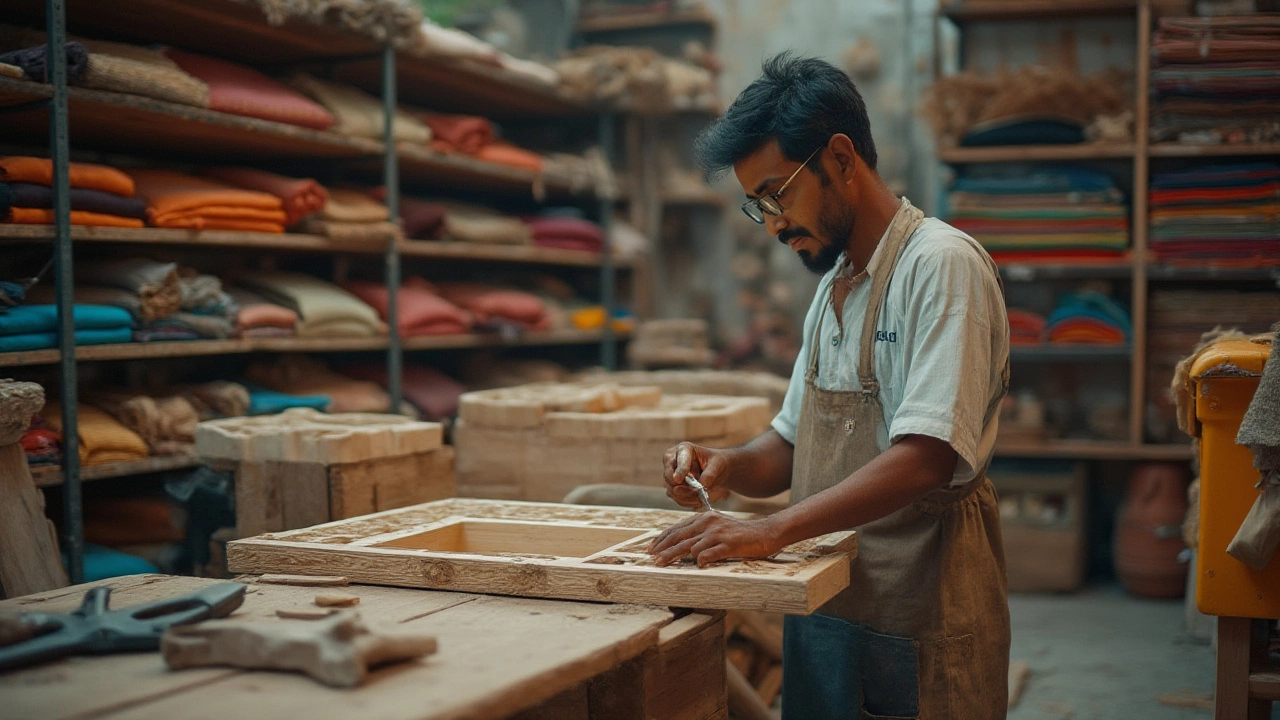How to Spot a High-Quality Sofa: Your Essential Guide to Sofa Durability and Comfort

Take a minute and imagine sinking into a couch after a long day—and instead of comfort, you feel bumps, saggy fabric, and a few squeaks from the frame. Frustrating, right? Not all sofas are made the same, but distinguishing a real quality sofa from a cheap knockoff isn’t as obvious as it should be. Price tags can be misleading, trendy shapes aren’t always reliable, and brand names sometimes promise more than they deliver. If you want a sofa that doesn’t turn into a lumpy mess after a year or feel regret the first time someone spills red wine, you need to know what to look for. Here’s the real story—without the fluff—on how to tell a quality sofa before you buy (or regret) it.
The Heart of the Sofa: Frame, Suspension, and Construction
Let’s cut through the hype—if the frame is weak, the sofa will fall apart no matter how pretty it looks. High-quality sofas start with a solid hardwood frame, usually kiln-dried hardwoods like beech, maple, or oak. Why kiln-dried? Because treating the wood removes moisture and reduces the risk of warping or cracking down the line. That’s why cheap sofas with softwoods, thin plywood, or even particleboard frames never last. If you can, ask what wood the frame is made from or look for that info online. Avoid particleboard or frames held together with just staples and glue. Quality frames use double dowels, wood corner blocks, or metal brackets—all signs the sofa was designed to last.
A sofa’s comfort and longevity also depend on suspension. The industry gold standard is the eight-way hand-tied spring system. Craftspeople string coils together with twine in eight directions, which makes for unbeatable comfort and even support. This process is time-consuming and expensive, so you only see it in higher-end sofas. Sinuous springs (thick S-shaped wires that run from front to back) are the next best thing—they’re found in mid-range sofas and provide decent support if they’re made from sturdy steel. Cheaper options might use webbing (strips of fabric or rubber) stretched across the frame, which feels bouncy at first but sags pretty quickly. If you sit down and it creaks or sags, move on.
Here’s a quick look at common frame and suspension options:
| Feature | Top Quality | Standard | Avoid |
|---|---|---|---|
| Frame | Kiln-dried hardwood | Plywood (multiple layers) | Particleboard/MDF |
| Suspension | Eight-way hand-tied springs | Sinuous springs | Webbing |
Also, take a look underneath. Lift a corner (have someone sit on the opposite end if you're in the store). If it feels heavy, that's usually a good sign—substantial furniture typically uses dense, high-quality wood. Lightweight sofas are often made with thinner, cheaper materials. Another trick: Press gently near the joints; wobbly arms or legs mean the craftsmanship is subpar. The legs of a quality sofa are part of the frame or are securely bolted in—not just glued.
Cushion Clues: Materials, Fillings, and Comfort
Cushions are the difference between a sofa you hate after a month and one you never want to leave. Seat cushions stuffed with just cheap foam break down quickly. On the other hand, high-density polyurethane foam with a firmness rating of at least 1.8 pounds per cubic foot holds up better. Top-of-the-line sofas may even use a core of high-resilience foam wrapped in feathers or down for that cloud-like effect—but these need regular fluffing and may not be great for allergy sufferers.
If you see options like “poly-fiber fill,” especially for back cushions, be skeptical—these flatten fast. Instead, look for a mix: foam and feather wraps, a blend of real down mixed with clusters of polyfill, or even a pocketed coil interior (yes, like a mattress—these springs inside the seat cushion help keep its shape).
You want to test the seat by pressing on it—does it bounce back? Sit for a while and notice if you sink straight to the frame, or if you feel even support. Good cushions should return to their shape after use, not leave a dent. And check the comfort for your body type—what feels firm for one might be too soft for another. Here’s what you’ll commonly run into:
| Cushion Type | Pros | Cons |
|---|---|---|
| High-density foam | Firm, holds shape | Can feel stiff |
| Foam & Feather/Down | Soft, luxurious feel | Frequent fluffing needed, possible allergies |
| Polyfill | Cheap, lightweight | Quickly loses shape |
| Pocketed coils | Long-lasting support | Rare, expensive |
Remember, back and seat cushions don’t have to match—mixing a firmer seat cushion with a plusher back is a sign of a thoughtful design. Removable, reversible cushions are another green flag; they last longer since you can flip them to even out wear.

Fabric and Upholstery: Durability, Style, and Cleanability
The fabric makes the first impression—and faces the wildest wear and tear. Natural fabrics like cotton and linen feel great but can stain or fade if you’re not careful. Synthetics like polyester or microfiber are tough as nails and handle daily chaos from pets and kids. Leather is strong and ages well, but not all leathers are equal—the best is full-grain or top-grain, not “bonded” or split hides glued together.
Check the fabric’s “rub count.” This number, called the Martindale or Wyzenbeek test, tells you how many times a fabric can be rubbed before it shows wear. Anything above 15,000 rubs is safe for heavy home use. Commercial spaces need even higher scores. Want a family-proof sofa? Go for stain-resistant treatments, performance fabrics like Crypton or Sunbrella, or at least a tight weave. If you’re in the store, ask for a swatch and do the “scratch test”—rub it hard with your fingernails to see how it holds up.
Patterns that are woven in, rather than printed, last much longer. For seams, look for even, straight stitching; double stitching means extra strength. Zippers for removable covers are a plus, especially if you're dealing with kids or pets—machine-washable covers mean a lot less stress.
Here’s a rundown of common fabric types and what they handle best:
| Fabric Type | Pros | Cons |
|---|---|---|
| Leather (Full/Top Grain) | Durable, ages well | Expensive, sensitive to scratches |
| Microfiber/Polyester | Easy to clean, pet/kid friendly | Can pill, may feel synthetic |
| Cotton/Linen | Soft, breathable | Stains, wrinkles easily |
| Velvet | Luxurious look/feel | Shows marks, harder to clean |
Don’t forget about color. Light tones make small spaces look bigger but mark faster; dark shades hide stains but might fade near a sunny window. Patterns and textured weaves camouflage daily dirt. If you’re into trends, remember you'll be living with this look for years, so think twice about going too bold unless you’re certain you won’t get tired of it. And if you’ve got a chaotic home, “performance fabric” is your best friend—it’s designed to repel stains, resist fading, and survive heavy traffic.
Details, Warranties, and Smart Shopping Tricks
Now, here’s where a little sleuthing pays off. Stitching should be straight and even, with reinforced seams at the corners. Zippers should glide smoothly, and buttons must be sewn tight. If tufting is part of the design, make sure it uses actual buttons or knots—not just imitation tacks glued on top. Removable covers or extra slipcovers make deep cleaning a breeze, especially for sofas in busy households. And don’t forget to check under the cushions—a dust cover on the underside is typical, but anything sagging or stapled haphazardly is a sign of shortcuts.
Ask about the warranty. Reputable manufacturers will stand by their product, often giving frame warranties of 10 years or more. If it’s only covered for a year, or if the warranty sounds vague, that sofa probably isn’t built to last for the long haul.
Try the “lift test.” Grab one end and see if you can tip up a corner; quality sofas have weight because of solid frames and springs. If it’s light as a feather, the frame may be hollow or filled with cheap wood. Run your hand along the back and arms—well-padded arms feel firm but with some give, and backs shouldn’t feel hollow or wobbly when you press.
Shopping online? Read the fine print on returns and make sure to check out close-up images of seams, legs, and cushions—not just the sofa posed in a pretty living room. Customer reviews can be gold—look for comments about long-term comfort, sagging issues, and how the fabric wears with real use, not just on day one.
Here are some practical shopping tips you’ll actually use:
- Measure your space before you shop. Factor in doorways, hallways, and corners—you’d be amazed how many people buy a sofa that won’t even fit inside.
- Test drive several sofas in person. Sit, lean, lie back, and move around. If you share your sofa, bring your family or roommates and check for comfort at the same time.
- Check the manufacturer’s country of origin—in the sofa world, labels like “made in Italy” or “handcrafted in North Carolina” often signal reputable construction.
- Look for certifications if you care about environmental or health issues—GREENGUARD, CertiPUR-US, or FSC labels tell you about formaldehyde, chemical use, or sustainable wood sourcing.
To sum it up, a quality sofa stands out with solid hardwood frames, strong (preferably hand-tied) springs, high-resilience foam or feather-wrapped cushions, tough and cleanable fabric, and sturdy, detailed construction. The best sofas are an investment—they look better as they age, feel comfortable year after year, and turn into everyone’s favorite seat in the house. Don’t fall for just a style or a flashy tag; dig a little deeper and you’ll bring home a couch that truly pays you back every day you own it.